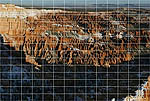 The Gigapixel Image
The Gigapixel Image
By
Mike Pasini, The Imaging Resource
(Tuesday, December 2, 2003 - 20:15 EST)
Dave woke us up from our afternoon nap with his trademark, "Check it out!" He'd just read about Max Lyons gigapixel landscape image made from 196 individual photos taken with a Canon D60 6-Mp digicam. The images were subsequently stitched together into a single file.
"Just saw this on Slashdot -- a gigapixel image!" he shook us. "Mike! Mike! Can you get this up on the news page?"
Fortunately, we weren't installing Panther, Apple's latest version of OS X, on our cluster of G5s. Inexplicably, they hadn't arrive yet.
"Well, Dave," we slowed him down, "I've actually been downloading the image for the last two days on my spare 1200 baud modem. In fact, I may break Rip Van Winkle's record for longest nap during an image download if I don't get hypnotized by the spinning cursor first."
Apparently, a one gigapixel image takes a lot of bandwidth.
So, breaking our usual habit of linking everything in sight, we are not posting a link to the famous image. Not until we actually see it ourselves, that is.
DETAILS
Meanwhile, we were able to scrounge some details from the discussion on Slashdot.
Max told the Slashot contributor "michael" (not related) that he had not been able to find a "higher resolution photographic (i.e. non-scientific) digital image that has been created without resizing a smaller, lower resolution image or using an interpolated image."
His technique, according to an early visitor to his site who claimed to have actually gotten the URL to display, involves using a tripod to rotate the camera around the nodal point to take the overlapping images in several rows. The were processed using Helmut Dersch's PanoTools. Additional challenges included the 2-GB address space limit in Windows (and most 32-bit Linux builds) and application support for images larger than 16-bit signed coordinate space.
Then, of course, the So-What Chorus chimed in. One poster noted, "Images like this are common in GIS applications, often orthorectified product stitched into a seamless continuous image map of massive areas of terrain, these images are vast, far in excess of a gigapixel." He cited airphotousa.com and earthviewer.com as examples.
And then there was the guy who was disappointed in the subject matter. He was hoping for something less landscapy and more body scannish. But others were quick to point out that level of detail would likely spoil the fun.
STAY TUNED
Despite the holiday season, we intend to stay on top of this story. We expect to have a thumbnail compiled after downloading the gigapixel image and running it through our garlic press (avoiding file size limits) to isolate the 196 original images, a pixel from each of which we'll contribute to the thumbnail. Maybe we'll call it JPEG 2004. Look for it early in April, when we should have the cluster humming along, too.
MORE DETAILS!
The site is back up, so we actually did a little research. Here's a few interesting facts sure to be on the next "Who Wants to Be a Millionaire":
� Final image dimensions: 40,784 x 26,800 pixels
� Number of pixels in final image: 1,093,011,200 (1.09 gigapixel)
� Final image file format: RGB Tiff using deflate compression
� Final image file size: 2,068,654,055 bytes
� Number of source images: 196
� Number of pixels in source images: 1,233,125,376 (196 images * 3072*2048)
� Lens focal length: 280mm (equivalent to 450mm on a 35mm camera)
� Aperture: F9. Shutter speed: 1/400
� Number of control points in PTAssembler project: 779
� Number of seams that were manually blended after stitching: 364
� Horizontal field of view of final image: 63 degrees
� Time required to capture component images: 13 minutes
� Time required to set control points: 2 hours
� Time required to optimize project: 2 days
� Time required to stitch project: 4 days
� Time required to blend seams / correct misalignments / finalize image: 3 days
|